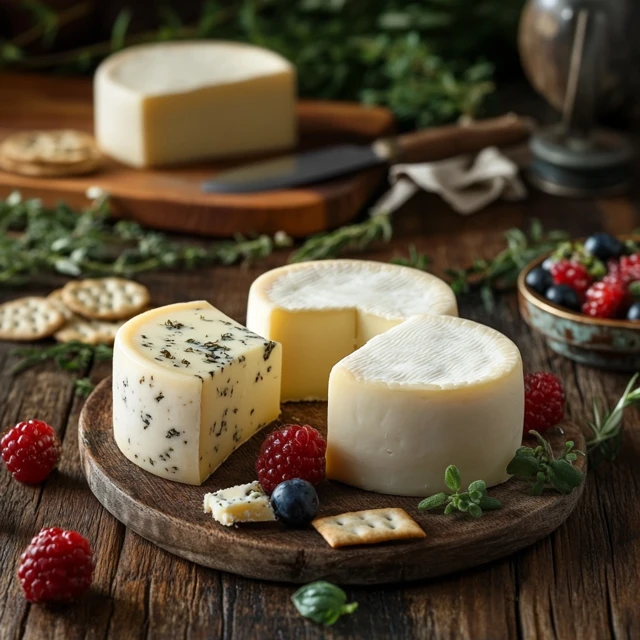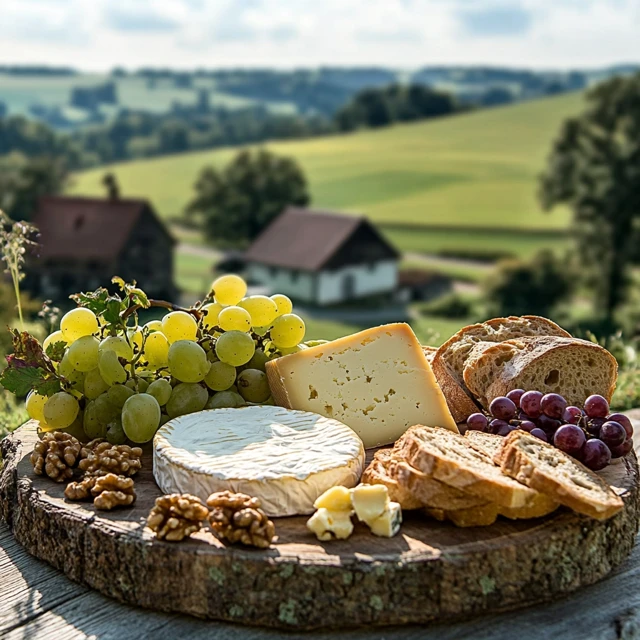Welcome to the fascinating realm of Havarti cheese, a renowned Danish heritage cheese that has garnered worldwide acclaim. Moreover, this comprehensive guide will thoroughly explore its rich history, distinctive characteristics, and versatile applications, making it an essential addition to your cheese collection.
Furthermore, we’ll delve deeply into Havarti’s origins, historical development, and contemporary production methods. Additionally, you’ll discover its diverse varieties and flavor profiles. Most importantly, we’ll examine the nutritional benefits and health considerations associated with Havarti cheese. Therefore, whether you’re a cheese enthusiast or simply seeking culinary exploration, this guide provides valuable insights for your journey.

Havarti cheese features a distinctive creamy texture and mild flavor profile. Indeed, from its rich Danish heritage to its contemporary applications, Havarti cheese proves consistently versatile. Furthermore, as we embark on this exploration, you’ll discover the remarkable qualities that make this cheese truly exceptional.
Key Takeaways
- Learn about the history and origins of Havarti cheese and its Danish heritage
- Discover the unique properties and flavor profiles of Havarti cheese
- Understand the nutritional benefits and health considerations of consuming Havarti cheese
- Explore the various uses and applications of Havarti cheese in cooking and everyday meals
- Get tips on how to select and store high-quality Havarti cheese as part of your cheese guide
For more , check out https://eassyrecipes.com/cottage-cheese-flatbread/
The Rich Danish Heritage of Havarti Cheese
Havarti cheese boasts a rich heritage dating back to 19th century Denmark. Indeed, this beloved Danish cheese has endured through generations, while its narrative intertwines innovation with tradition, notably featuring Hanne Nielsen as a pivotal figure.
Furthermore, the mid-19th century marked the beginning of Havarti’s remarkable journey. Specifically, Danish farmers began experimenting with novel approaches to cheese production. Subsequently, these innovative cheese-making techniques significantly enhanced both the quality and consistency of Havarti production.
Origins in 19th Century Denmark
In 19th century Denmark, agricultural practices underwent significant transformation. Notably, farmers shifted their focus toward enhanced dairy production. Consequently, this agricultural revolution led to increased milk yields and innovative cheese varieties, including Havarti.
Hanne Nielsen’s Revolutionary Cheese-Making
Hanne Nielsen emerged as a trailblazer in Danish cheese-making. Specifically, she introduced innovative techniques to the craft. Furthermore, her pioneering use of new bacterial cultures and aging methods ultimately created the unique characteristics of Havarti we know today.

Evolution into Modern Production
Today, Havarti cheese skillfully blends traditional and modern methods. Furthermore, the Danish cheese industry has experienced significant growth, as it now emphasizes quality, sustainability, and innovation. Consequently, these developments have established Havarti as a global favorite, particularly renowned for its rich heritage and distinctive taste.
| Year | Event | Description |
|---|---|---|
| 19th century | Introduction of new cheese-making techniques | Danish dairy farmers began experimenting with new methods, leading to the development of Havarti cheese |
| Mid-19th century | Hanne Nielsen’s innovative cheese-making techniques | Nielsen’s methods transformed the cheese-making history of Havarti, creating a distinctive flavor and texture |
| Present day | Modern production techniques | The Danish cheese industry has evolved, with a focus on quality control, sustainability, and innovation |
Understanding the Unique Properties of Havarti
Havarti, a distinctive semi-soft cheese, features a mild, buttery flavor and smooth texture. Moreover, its versatility shines in various dishes, from grilled sandwiches to cheese platters. Additionally, when consumed in moderation, it provides valuable nutritional benefits.
Some of the key characteristics of Havarti include:
- A semi-soft texture that melts well and adds creaminess to dishes
- A mild, buttery flavor that complements a variety of ingredients
- A high moisture content that makes it perfect for snacking and cooking
Havarti’s unique properties make it a favorite among cheese lovers and chefs. It’s versatile and has a rich taste. This makes it a great choice for any meal or snack.
If you love cheese or want to try something new, Havarti is a great pick. Its rich taste and smooth texture are perfect for enjoying the best of dairy.
For more , check out https://eassyrecipes.com/cottage-cheese-flatbread/
How Havarti Cheese Is Made Today
Havarti cheese production blends traditional methods with modern technology. Initially, the process begins with careful curd formation. Subsequently, shaping and aging develop its distinctive characteristics.
Moreover, while traditional techniques rely on manual craftsmanship, modern innovations have enhanced efficiency. Consequently, these technological advances enable increased production while maintaining exceptional quality standards.
Quality Control and Aging Process
Quality control plays a vital role in cheese making. Specifically, throughout the aging period, which spans from months to years, careful monitoring and frequent turning of the cheese ultimately brings out its optimal flavor and texture. Moreover, this meticulous oversight therefore ensures consistent quality standards throughout the production process.
- Advanced pasteurization techniques to improve safety and consistency
- Automated cutting and shaping machines to reduce labor and increase efficiency
- Computer-controlled aging rooms to maintain optimal temperature and humidity conditions
By mixing old ways with new tech, cheese making is better and more consistent. Yet, it keeps Havarti cheese’s unique taste and feel.
| Traditional Methods | Modern Manufacturing |
|---|---|
| Manual labor and time-honored techniques | Advanced technologies and automated processes |
| Small-scale production | Large-scale production with improved efficiency |
Varieties and Flavor Profiles
Havarti cheese encompasses diverse cheese varieties, each offering distinct flavor profiles. Specifically, from semi-soft to aged variations, these types deliver unique experiences for cheese enthusiasts. Furthermore, as a notable member of dairy products, Havarti has earned widespread popularity through its characteristic mild, buttery taste and smooth texture.
Some popular types of Havarti cheese include:
- Semi-soft Havarti: a mild, creamy cheese perfect for snacking or grating
- Aged Havarti: a stronger, more pronounced flavor with a crumbly texture
- Flavored Havarti: infused with herbs, spices, or other ingredients for added flavor
Exploring Havarti cheese reveals diverse flavor profiles and cheese varieties. In fact, whether you prefer mild or bold tastes, there’s undoubtedly a Havarti variant to suit your palate. Furthermore, as a versatile member of the dairy products family, Havarti stands out as an excellent choice for any occasion.
For more , check out https://eassyrecipes.com/cottage-cheese-flatbread/
Nutritional Benefits and Health Considerations
Havarti cheese serves as an excellent choice for a balanced diet due to its rich flavor and creamy texture. Importantly, it provides substantial protein, calcium, and other essential nutrients.
Moreover, those with mild lactose intolerance can often tolerate Havarti well. However, mindful portion control remains crucial, as a single 1-ounce serving contains approximately 100 calories.
Key Nutrients in Havarti
Havarti cheese is rich in several important nutrients:
- Protein: 6-7 grams per ounce
- Calcium: 20-25% of the daily recommended intake per ounce
- Vitamin B12: 10-15% of the daily recommended intake per ounce
Dietary Considerations
When adding Havarti cheese to your diet, keep these points in mind:
- Lactose intolerance: Havarti has less lactose, but watch your portions.
- Calorie intake: With 100 calories per ounce, balance it with other foods.
Portion Control and Daily Values
To enjoy Havarti cheese’s benefits, follow these daily values:
| Nutrient | Daily Value |
|---|---|
| Protein | 50 grams |
| Calcium | 1,000 mg |
| Vitamin B12 | 2.4 mcg |
By controlling portions and balancing with other foods, you can enjoy Havarti’s benefits. This way, you can also consider dietary needs.
Culinary Applications and Recipe Ideas
Havarti cheese serves as a versatile ingredient for numerous culinary uses, adapting seamlessly to both casual snacks and sophisticated dishes. Indeed, its mild flavor profile and semi-soft texture make it remarkably versatile in both hot and cold recipe ideas, enhancing everything from elegant charcuterie boards to comforting meals.
Furthermore, Havarti’s applications extend widely, from being grated over pasta to layered in sandwiches or crumbled atop salads. Additionally, it excels as a soup garnish or stuffed vegetable filling. Most notably, it transforms into luxurious fondues or creamy dips for special occasions.
- Havarti and fig jam crostini: a sweet and savory combination that’s perfect for a quick snack or appetizer
- Havarti and spinach stuffed chicken breasts: a hearty, comforting meal that’s sure to become a family favorite
- Havarti and pear salad: a light, refreshing salad that’s perfect for a summer evening
Havarti cheese adds a rich, buttery flavor to any meal. It’s versatile and perfect for any skill level in the kitchen. So, why not get creative and start cooking with cheese today?
Storing and Serving Your Havarti Cheese
To enjoy your Havarti cheese to the fullest, proper storage and serving techniques are essential. Specifically, correct storage maintains the cheese’s freshness and flavor, while serving it at the optimal temperature enhances its distinctive taste and texture.
For effective cheese storage, first place Havarti in a cool, dry environment, protected from direct sunlight. Additionally, wrap it carefully in plastic or foil before refrigerating to maintain moisture. Finally, for the most desirable taste experience, allow it to reach room temperature, ideally between 68°F and 72°F, before serving.
Optimal Serving Temperature
The ideal serving temperature for Havarti cheese ranges between 68°F and 72°F. Specifically, this temperature range optimally softens the cheese while effectively releasing its distinctive flavors and aromatic properties.
Cheese Pairing Suggestions
Havarti cheese pairs wonderfully with many foods and drinks. Specifically, it complements fresh fruits like grapes and berries, while also enhancing crackers and bread. Moreover, for an elegant dining experience, it pairs exceptionally well with wines such as Chardonnay or Merlot.
By following these tips, you’ll get the most out of your Havarti cheese. Enjoy it as a snack, in recipes, or with your favorite foods and drinks.
Buying Guide: How to Select Quality Havarti
Choosing good quality cheese requires careful attention. Specifically, Havarti’s soft texture and mild taste make it perfect for many dishes. Moreover, its pure milk source and balanced flavors indicate that it’s truly a superior cheese.
Also, a helpful buying guide shows the different kinds of Havarti. You can pick from plain, smoked, or flavored types. Each kind has its own taste, so you can choose what you like best.
- Origin: Choose cheese from top dairy farms.
- Age: Different ages change the flavor and texture.
- Packaging: Make sure it’s not damaged or tampered with.
Follow this buying guide to find a quality cheese that will make your meals better.
FAQs About Havarti Cheese
What cheese does Havarti taste like?
Havarti cheese has a mild, buttery flavor combined with a creamy texture. While often compared to Monterey Jack in terms of taste, Havarti nonetheless has a slightly richer and tangier profile. Furthermore, its subtle sweetness makes it a particularly versatile choice that consequently pairs well with a variety of foods.
What kind of cheese is Havarti similar to?
Havarti is similar to other semi-soft cheeses like Gouda and Monterey Jack. Its creamy texture and mild flavor make it comparable to these cheeses, but Havarti stands out with its distinct buttery and slightly tangy notes. It also shares melting properties with cheeses like mozzarella, making it ideal for recipes requiring smooth, creamy results.
Is Havarti and Gouda the same?
No, Havarti and Gouda are not the same, although they share some similarities. Both are semi-soft cheeses and have a creamy texture. However, Gouda has a nuttier and more caramel-like flavor, especially when aged, while Havarti has a milder, buttery taste. Gouda also tends to be firmer than Havarti.
What is the best use of Havarti cheese?
Havarti cheese is incredibly versatile, but its best uses include:
- Grilled cheese sandwiches: Its creamy melt makes it perfect for a classic grilled cheese.
- Charcuterie boards: Pair it with fruits, nuts, and crackers for a sophisticated appetizer.
- Baking and cooking: Use it in casseroles, quiches, or baked pasta dishes for a creamy, flavorful touch.
- Everyday snacking: Slice it for sandwiches or enjoy it on its own with crackers.
Havarti’s ability to melt smoothly and its mild flavor make it suitable for a wide range of dishes.
Conclusion: Why Havarti Deserves a Place in Your Cheese Collection
Havarti cheese is a special treat with a long history. Originally developed in 19th-century Denmark, it has since become beloved worldwide. Moreover, its semi-soft texture and rich taste make it a favorite among cheese lovers.
Furthermore, the flavor of Havarti can range from mild and creamy to bold and nutty. As a versatile cheese, it’s excellent for many dishes, such as grilled cheese and charcuterie boards. Additionally, it melts well, making it ideal for sauces and baked goods. Most importantly, it’s nutritious, adding health benefits to your cheese collection.
Whether you’re a longtime Havarti enthusiast or just discovering it, we hope this guide has sparked your interest. Therefore, we encourage you to try it in your cooking and experience its unique taste and texture. Indeed, it remains a vital part of both Danish and global cheese culture.

